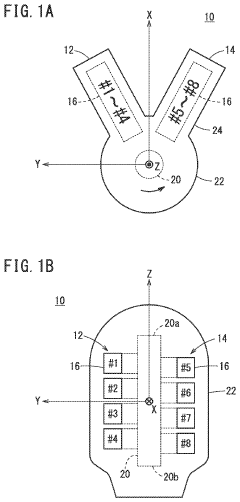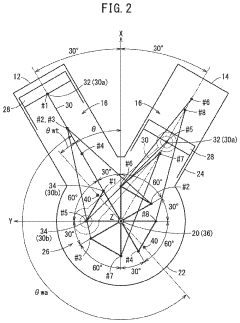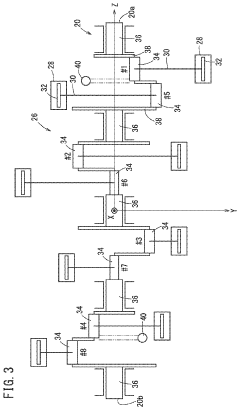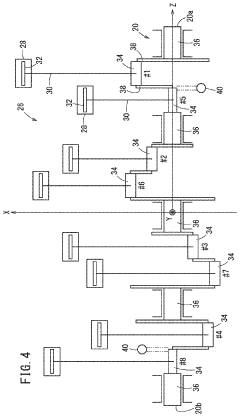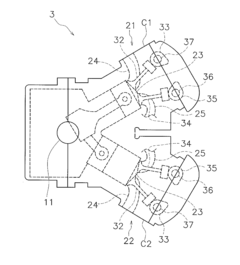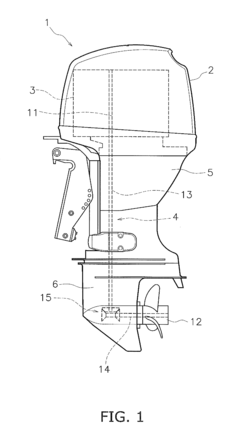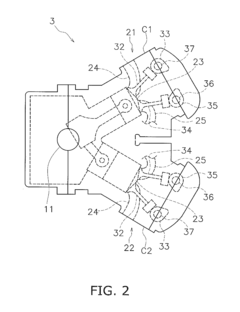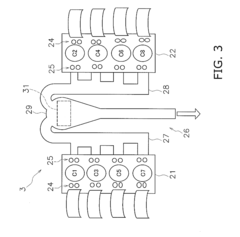V8 Engine Evolution: Key Design Changes Over Time
JUL 4, 20259 MIN READ
Generate Your Research Report Instantly with AI Agent
Patsnap Eureka helps you evaluate technical feasibility & market potential.
V8 Engine Background and Objectives
The V8 engine, a revolutionary internal combustion engine design, has been a cornerstone of automotive engineering since its inception in the early 20th century. Developed by Cadillac and introduced in 1914, the V8 engine configuration has undergone significant evolution over the past century, adapting to changing technological capabilities, environmental regulations, and consumer demands.
Initially conceived to provide smooth and powerful performance for luxury vehicles, the V8 engine quickly became synonymous with American automotive culture. Its compact design, relative to inline engines of similar displacement, allowed for better packaging in vehicle engine bays while delivering impressive power output. The V8's inherent balance and characteristic sound further contributed to its popularity among enthusiasts and manufacturers alike.
Throughout its history, the V8 engine has seen numerous design changes aimed at improving performance, efficiency, and reliability. Early V8 engines were typically flathead designs, with the valves located in the engine block. The introduction of overhead valve (OHV) designs in the 1940s and 1950s marked a significant leap forward, allowing for better breathing and increased power output.
The 1960s and 1970s saw the rise of high-performance V8 engines, particularly in muscle cars and racing applications. This era brought about advancements in camshaft profiles, intake and exhaust systems, and fuel delivery methods. However, the oil crisis of the 1970s and subsequent emissions regulations posed new challenges for V8 engine designers, necessitating a shift towards improved fuel efficiency and reduced emissions.
In response to these challenges, manufacturers began implementing technologies such as electronic fuel injection, variable valve timing, and cylinder deactivation. These innovations allowed V8 engines to maintain their performance characteristics while meeting increasingly stringent environmental standards.
The primary objective in V8 engine evolution has been to strike a balance between power, efficiency, and environmental responsibility. Modern V8 engines employ advanced materials, precision manufacturing techniques, and sophisticated engine management systems to achieve this goal. The integration of turbocharging and supercharging has further enhanced the V8's capabilities, allowing for smaller displacement engines to produce power levels previously associated with larger naturally aspirated units.
As the automotive industry moves towards electrification, the role of V8 engines is evolving. While they continue to power high-performance vehicles and luxury cars, manufacturers are exploring hybrid V8 powertrains and even fully electric alternatives that aim to replicate the character and performance of traditional V8 engines.
Initially conceived to provide smooth and powerful performance for luxury vehicles, the V8 engine quickly became synonymous with American automotive culture. Its compact design, relative to inline engines of similar displacement, allowed for better packaging in vehicle engine bays while delivering impressive power output. The V8's inherent balance and characteristic sound further contributed to its popularity among enthusiasts and manufacturers alike.
Throughout its history, the V8 engine has seen numerous design changes aimed at improving performance, efficiency, and reliability. Early V8 engines were typically flathead designs, with the valves located in the engine block. The introduction of overhead valve (OHV) designs in the 1940s and 1950s marked a significant leap forward, allowing for better breathing and increased power output.
The 1960s and 1970s saw the rise of high-performance V8 engines, particularly in muscle cars and racing applications. This era brought about advancements in camshaft profiles, intake and exhaust systems, and fuel delivery methods. However, the oil crisis of the 1970s and subsequent emissions regulations posed new challenges for V8 engine designers, necessitating a shift towards improved fuel efficiency and reduced emissions.
In response to these challenges, manufacturers began implementing technologies such as electronic fuel injection, variable valve timing, and cylinder deactivation. These innovations allowed V8 engines to maintain their performance characteristics while meeting increasingly stringent environmental standards.
The primary objective in V8 engine evolution has been to strike a balance between power, efficiency, and environmental responsibility. Modern V8 engines employ advanced materials, precision manufacturing techniques, and sophisticated engine management systems to achieve this goal. The integration of turbocharging and supercharging has further enhanced the V8's capabilities, allowing for smaller displacement engines to produce power levels previously associated with larger naturally aspirated units.
As the automotive industry moves towards electrification, the role of V8 engines is evolving. While they continue to power high-performance vehicles and luxury cars, manufacturers are exploring hybrid V8 powertrains and even fully electric alternatives that aim to replicate the character and performance of traditional V8 engines.
Market Demand Analysis for V8 Engines
The market demand for V8 engines has undergone significant shifts over the past decades, driven by changing consumer preferences, regulatory pressures, and technological advancements. Initially, V8 engines were synonymous with power and performance, particularly in the North American market where large displacement engines were favored in muscle cars, trucks, and luxury vehicles.
In the automotive sector, V8 engines have traditionally been associated with high-end sports cars, luxury sedans, and full-size pickup trucks. The demand for these engines has been strong in markets where fuel costs are relatively low and consumers prioritize performance over efficiency. However, the global trend towards improved fuel economy and reduced emissions has put pressure on manufacturers to reconsider their V8 offerings.
Despite these challenges, there remains a niche market for V8 engines, particularly in performance vehicles and premium segments. Manufacturers have responded by developing more efficient V8 engines, incorporating technologies such as direct injection, variable valve timing, and cylinder deactivation. These advancements have allowed V8 engines to maintain relevance in a market increasingly focused on sustainability.
The commercial vehicle sector, including heavy-duty trucks and industrial equipment, continues to show demand for V8 engines due to their torque characteristics and durability. In marine applications, V8 engines are still popular for their power-to-weight ratio and reliability in demanding environments.
Looking at market trends, the global V8 engine market has seen a gradual decline in volume, but an increase in value as these engines become more specialized and technologically advanced. The automotive industry's shift towards electrification has further impacted the V8 market, with some manufacturers phasing out V8 options in favor of turbocharged six-cylinder engines or hybrid powertrains.
However, the emotional appeal and brand heritage associated with V8 engines continue to drive demand among enthusiasts and in certain vehicle categories. This has led to the development of high-performance V8 variants that serve as halo products for automotive brands, maintaining the engine's prestige and desirability.
In conclusion, while the overall market for V8 engines is contracting due to environmental concerns and shifting consumer preferences, there remains a significant niche demand. The future of V8 engines likely lies in specialized applications, where their unique characteristics continue to offer value to consumers and industries that prioritize power, torque, and the distinctive driving experience they provide.
In the automotive sector, V8 engines have traditionally been associated with high-end sports cars, luxury sedans, and full-size pickup trucks. The demand for these engines has been strong in markets where fuel costs are relatively low and consumers prioritize performance over efficiency. However, the global trend towards improved fuel economy and reduced emissions has put pressure on manufacturers to reconsider their V8 offerings.
Despite these challenges, there remains a niche market for V8 engines, particularly in performance vehicles and premium segments. Manufacturers have responded by developing more efficient V8 engines, incorporating technologies such as direct injection, variable valve timing, and cylinder deactivation. These advancements have allowed V8 engines to maintain relevance in a market increasingly focused on sustainability.
The commercial vehicle sector, including heavy-duty trucks and industrial equipment, continues to show demand for V8 engines due to their torque characteristics and durability. In marine applications, V8 engines are still popular for their power-to-weight ratio and reliability in demanding environments.
Looking at market trends, the global V8 engine market has seen a gradual decline in volume, but an increase in value as these engines become more specialized and technologically advanced. The automotive industry's shift towards electrification has further impacted the V8 market, with some manufacturers phasing out V8 options in favor of turbocharged six-cylinder engines or hybrid powertrains.
However, the emotional appeal and brand heritage associated with V8 engines continue to drive demand among enthusiasts and in certain vehicle categories. This has led to the development of high-performance V8 variants that serve as halo products for automotive brands, maintaining the engine's prestige and desirability.
In conclusion, while the overall market for V8 engines is contracting due to environmental concerns and shifting consumer preferences, there remains a significant niche demand. The future of V8 engines likely lies in specialized applications, where their unique characteristics continue to offer value to consumers and industries that prioritize power, torque, and the distinctive driving experience they provide.
V8 Engine Technical Challenges
The V8 engine, a cornerstone of modern automotive technology, has faced numerous technical challenges throughout its evolution. One of the primary hurdles has been the optimization of fuel efficiency while maintaining or improving performance. Engineers have grappled with the complex task of reducing fuel consumption without compromising the power output that V8 engines are known for.
Another significant challenge has been meeting increasingly stringent emissions regulations. As environmental concerns have grown, V8 engine designers have had to develop innovative solutions to reduce harmful exhaust emissions, particularly nitrogen oxides (NOx) and carbon dioxide (CO2). This has led to the integration of advanced emission control systems and the exploration of alternative fuel technologies.
The pursuit of weight reduction has also posed a considerable challenge. V8 engines are traditionally known for their substantial mass, which can negatively impact vehicle dynamics and fuel efficiency. Engineers have been tasked with finding ways to reduce engine weight without sacrificing structural integrity or performance characteristics.
Thermal management has been another critical area of focus. V8 engines generate significant heat, and managing this thermal load efficiently is crucial for maintaining performance, reliability, and longevity. Developing effective cooling systems that can handle the heat output while minimizing parasitic losses has been an ongoing challenge.
The integration of advanced technologies, such as direct fuel injection, variable valve timing, and cylinder deactivation, has presented its own set of challenges. These technologies, while offering significant benefits, have required complex control systems and precise calibration to function optimally within the V8 architecture.
Durability and reliability have remained constant concerns throughout the V8's evolution. As engines have become more powerful and sophisticated, ensuring that they can withstand increased stresses and maintain performance over extended periods has been a critical focus for engineers.
The shift towards electrification and hybrid powertrains has introduced new challenges for V8 engine development. Integrating electric motors and battery systems while preserving the characteristic V8 experience has required innovative approaches to powertrain design and packaging.
Lastly, the challenge of noise, vibration, and harshness (NVH) reduction has been significant. While the V8's distinctive sound is often celebrated, engineers have had to find ways to mitigate unwanted vibrations and harshness to meet modern comfort standards without losing the engine's emotive qualities.
Another significant challenge has been meeting increasingly stringent emissions regulations. As environmental concerns have grown, V8 engine designers have had to develop innovative solutions to reduce harmful exhaust emissions, particularly nitrogen oxides (NOx) and carbon dioxide (CO2). This has led to the integration of advanced emission control systems and the exploration of alternative fuel technologies.
The pursuit of weight reduction has also posed a considerable challenge. V8 engines are traditionally known for their substantial mass, which can negatively impact vehicle dynamics and fuel efficiency. Engineers have been tasked with finding ways to reduce engine weight without sacrificing structural integrity or performance characteristics.
Thermal management has been another critical area of focus. V8 engines generate significant heat, and managing this thermal load efficiently is crucial for maintaining performance, reliability, and longevity. Developing effective cooling systems that can handle the heat output while minimizing parasitic losses has been an ongoing challenge.
The integration of advanced technologies, such as direct fuel injection, variable valve timing, and cylinder deactivation, has presented its own set of challenges. These technologies, while offering significant benefits, have required complex control systems and precise calibration to function optimally within the V8 architecture.
Durability and reliability have remained constant concerns throughout the V8's evolution. As engines have become more powerful and sophisticated, ensuring that they can withstand increased stresses and maintain performance over extended periods has been a critical focus for engineers.
The shift towards electrification and hybrid powertrains has introduced new challenges for V8 engine development. Integrating electric motors and battery systems while preserving the characteristic V8 experience has required innovative approaches to powertrain design and packaging.
Lastly, the challenge of noise, vibration, and harshness (NVH) reduction has been significant. While the V8's distinctive sound is often celebrated, engineers have had to find ways to mitigate unwanted vibrations and harshness to meet modern comfort standards without losing the engine's emotive qualities.
Current V8 Engine Design Solutions
01 Cylinder arrangement and configuration
V8 engine designs focus on the arrangement and configuration of cylinders. This includes optimizing the V-angle between cylinder banks, typically at 90 degrees, to balance engine performance and vibration reduction. The layout also considers factors such as compact design, weight distribution, and overall engine efficiency.- Cylinder arrangement and configuration: V8 engine designs focus on the arrangement and configuration of cylinders. This includes optimizing the V-angle between cylinder banks, typically at 90 degrees, to achieve better balance and compact design. The layout affects engine performance, vibration characteristics, and overall dimensions.
- Crankshaft and firing order optimization: Innovations in V8 engine design involve optimizing the crankshaft design and firing order. This includes developing cross-plane and flat-plane crankshafts, each offering different performance characteristics. The firing order is carefully selected to balance power delivery, reduce vibration, and improve engine efficiency.
- Valve train and camshaft innovations: Advancements in V8 engine design focus on valve train components and camshaft configurations. This includes developing variable valve timing systems, implementing dual overhead camshafts (DOHC), and optimizing valve lift profiles. These innovations aim to improve engine breathing, increase power output, and enhance fuel efficiency across various operating conditions.
- Fuel injection and combustion optimization: Modern V8 engine designs incorporate advanced fuel injection systems and combustion chamber designs. This includes direct injection technology, variable fuel injection timing, and optimized piston crown shapes. These features aim to improve fuel atomization, enhance combustion efficiency, and reduce emissions while maintaining high performance.
- Thermal management and cooling systems: V8 engine designs focus on effective thermal management and cooling systems. This includes developing advanced coolant flow patterns, implementing precision cooling techniques, and optimizing oil cooling systems. These innovations aim to maintain optimal operating temperatures, improve engine efficiency, and enhance overall durability and longevity.
02 Crankshaft and firing order optimization
Innovations in V8 engine design involve optimizing the crankshaft design and firing order. This includes developing cross-plane or flat-plane crankshafts, each offering different performance characteristics. The firing order is carefully determined to balance power delivery, reduce vibration, and improve overall engine smoothness.Expand Specific Solutions03 Valve train and camshaft improvements
Advancements in V8 engine design focus on valve train and camshaft technologies. This includes developing variable valve timing systems, optimizing camshaft profiles, and implementing innovative valve actuation mechanisms. These improvements aim to enhance engine performance, fuel efficiency, and emissions control across various operating conditions.Expand Specific Solutions04 Fuel injection and combustion optimization
Modern V8 engine designs incorporate advanced fuel injection systems and combustion chamber optimizations. This includes developing direct injection technologies, improving fuel atomization, and enhancing air-fuel mixture formation. These innovations aim to increase power output, improve fuel efficiency, and reduce emissions in V8 engines.Expand Specific Solutions05 Thermal management and cooling systems
V8 engine designs focus on effective thermal management and cooling systems. This includes optimizing coolant flow paths, developing advanced cooling jackets, and implementing innovative heat dissipation techniques. These improvements aim to maintain optimal operating temperatures, enhance engine efficiency, and prolong component lifespan.Expand Specific Solutions
Major V8 Engine Manufacturers
The V8 engine evolution landscape is characterized by a mature market with ongoing innovation. Major players like BMW, Toyota, Honda, and Mercedes-Benz have been at the forefront of V8 development, continuously refining designs for improved performance and efficiency. The market size remains significant, particularly in luxury and high-performance segments. Technological advancements focus on balancing power output with fuel economy and emissions reduction. Companies like BorgWarner and GM Global Technology Operations contribute specialized expertise, while emerging players such as Cox Powertrain bring fresh perspectives to engine design. The competitive field is diverse, with traditional automakers and specialized engineering firms driving progress in V8 technology.
Bayerische Motoren Werke AG
Technical Solution: BMW has made notable improvements in V8 engine design over time. Their latest N63 and S63 V8 engines feature twin-scroll turbochargers for enhanced power and efficiency[13]. BMW has implemented Valvetronic variable valve lift technology, which eliminates the need for a traditional throttle body and improves engine response[14]. The company has also introduced a hot-vee turbocharger layout, placing the turbochargers between the cylinder banks for improved packaging and reduced turbo lag[15]. BMW's V8 engines now incorporate a high-precision direct fuel injection system and Double-VANOS variable camshaft timing for optimized performance across all RPM ranges[16].
Strengths: High performance, improved fuel efficiency, and advanced engine management systems. Weaknesses: Complexity of systems may lead to higher maintenance costs, and the focus on high-performance V8 engines may face challenges in markets prioritizing fuel economy and emissions reduction.
GM Global Technology Operations LLC
Technical Solution: GM has made significant strides in V8 engine evolution, particularly with their Small Block V8 series. The company has implemented direct fuel injection, which improves fuel efficiency and power output[1]. They've also introduced Active Fuel Management (AFM) technology, allowing the engine to operate on four cylinders during light load conditions, further enhancing fuel economy[2]. GM's latest V8 engines feature variable valve timing and lift, which optimizes performance across different RPM ranges[3]. Additionally, they've incorporated advanced materials such as aluminum block and heads to reduce weight while maintaining strength[4].
Strengths: Improved fuel efficiency, increased power output, and reduced emissions. Weaknesses: Complexity of systems may lead to higher maintenance costs, and the focus on V8 engines may conflict with industry trends towards smaller, turbocharged engines.
Key V8 Engine Innovations
V8 engine
PatentActiveUS11821359B2
Innovation
- The V8 engine configuration features crank pins arranged at 90° intervals on one bank and offset by 60° on the other bank, allowing for cancellation of primary inertia couples without additional specialized parts by optimizing the arrangement of crank pins and connecting rods.
V8 engine and outboard motor
PatentActiveUS20160341097A1
Innovation
- A V8 engine design with a simple construction featuring aggregated exhaust pathways and adjustable exhaust cams, where the central angle of exhaust cams for each cylinder is optimized to minimize valve overlap and reduce exhaust interference, allowing for even firing intervals and improved exhaust gas management.
Environmental Impact of V8 Engines
The environmental impact of V8 engines has been a significant concern throughout their evolution. As these powerful engines have undergone design changes over time, their effects on the environment have also shifted. Initially, V8 engines were notorious for their high fuel consumption and substantial emissions, contributing significantly to air pollution and greenhouse gas production.
Early V8 designs prioritized performance over efficiency, resulting in large displacement engines that consumed fuel at alarming rates. This excessive fuel consumption led to increased carbon dioxide emissions, exacerbating climate change concerns. Additionally, the incomplete combustion in these early engines produced higher levels of carbon monoxide and unburned hydrocarbons, further degrading air quality.
As environmental awareness grew, automotive manufacturers began implementing design changes to mitigate the negative impacts of V8 engines. One key development was the introduction of more efficient fuel injection systems, replacing carburetors. This improvement allowed for more precise fuel metering, reducing overall consumption and emissions.
Another significant advancement was the implementation of variable valve timing and lift technologies. These systems optimized engine performance across different operating conditions, improving fuel efficiency and reducing emissions, particularly at lower speeds and during partial load conditions.
The integration of cylinder deactivation technology marked a major milestone in V8 engine evolution. This feature allows the engine to operate on fewer cylinders during low-demand situations, substantially reducing fuel consumption and emissions during highway cruising or light-load conditions.
More recent design changes have focused on materials and manufacturing processes. The use of lighter materials, such as aluminum alloys, has reduced overall engine weight, contributing to improved fuel efficiency. Advanced manufacturing techniques have also allowed for tighter tolerances and improved combustion chamber designs, further enhancing efficiency and reducing emissions.
The introduction of direct fuel injection systems has been another crucial development in minimizing the environmental impact of V8 engines. This technology allows for more precise fuel delivery, resulting in improved combustion efficiency and reduced emissions across various operating conditions.
Despite these advancements, V8 engines still face challenges in meeting increasingly stringent environmental regulations. As a result, many manufacturers are exploring hybrid and electric technologies to complement or replace traditional V8 powertrains, aiming to further reduce the environmental footprint of high-performance vehicles.
Early V8 designs prioritized performance over efficiency, resulting in large displacement engines that consumed fuel at alarming rates. This excessive fuel consumption led to increased carbon dioxide emissions, exacerbating climate change concerns. Additionally, the incomplete combustion in these early engines produced higher levels of carbon monoxide and unburned hydrocarbons, further degrading air quality.
As environmental awareness grew, automotive manufacturers began implementing design changes to mitigate the negative impacts of V8 engines. One key development was the introduction of more efficient fuel injection systems, replacing carburetors. This improvement allowed for more precise fuel metering, reducing overall consumption and emissions.
Another significant advancement was the implementation of variable valve timing and lift technologies. These systems optimized engine performance across different operating conditions, improving fuel efficiency and reducing emissions, particularly at lower speeds and during partial load conditions.
The integration of cylinder deactivation technology marked a major milestone in V8 engine evolution. This feature allows the engine to operate on fewer cylinders during low-demand situations, substantially reducing fuel consumption and emissions during highway cruising or light-load conditions.
More recent design changes have focused on materials and manufacturing processes. The use of lighter materials, such as aluminum alloys, has reduced overall engine weight, contributing to improved fuel efficiency. Advanced manufacturing techniques have also allowed for tighter tolerances and improved combustion chamber designs, further enhancing efficiency and reducing emissions.
The introduction of direct fuel injection systems has been another crucial development in minimizing the environmental impact of V8 engines. This technology allows for more precise fuel delivery, resulting in improved combustion efficiency and reduced emissions across various operating conditions.
Despite these advancements, V8 engines still face challenges in meeting increasingly stringent environmental regulations. As a result, many manufacturers are exploring hybrid and electric technologies to complement or replace traditional V8 powertrains, aiming to further reduce the environmental footprint of high-performance vehicles.
V8 Engine Performance Metrics
The performance metrics of V8 engines have evolved significantly over time, reflecting the continuous advancements in engine design and technology. One of the key metrics is power output, which has seen substantial improvements through various design changes. Early V8 engines typically produced around 150-200 horsepower, while modern high-performance V8s can easily exceed 700 horsepower.
Fuel efficiency has also been a critical focus area for V8 engine development. Initially, V8 engines were known for their high fuel consumption, often achieving less than 15 miles per gallon. However, with the introduction of technologies such as direct fuel injection, variable valve timing, and cylinder deactivation, modern V8 engines can achieve fuel economy figures of 20-25 miles per gallon or more in some applications.
Emissions performance has become increasingly important, driven by stricter environmental regulations. V8 engines have made significant strides in reducing harmful emissions, particularly nitrogen oxides (NOx) and particulate matter. This has been achieved through advanced exhaust gas recirculation systems, catalytic converters, and precise engine management systems.
Torque output and delivery have also seen notable improvements. Early V8 engines often had narrow power bands, with peak torque available only at higher RPMs. Modern V8s, however, offer broader torque curves with peak torque available at lower RPMs, enhancing drivability and performance across a wider range of operating conditions.
Reliability and durability metrics have improved substantially. While early V8 engines often required frequent maintenance and had shorter lifespans, contemporary V8s can routinely achieve 200,000 miles or more with proper maintenance. This improvement is largely due to advancements in materials science, precision manufacturing techniques, and more robust lubrication systems.
Weight and compactness have become increasingly important performance metrics, particularly in the context of overall vehicle efficiency. Modern V8 engines have seen significant reductions in weight through the use of lightweight materials such as aluminum and composite components, without compromising on strength or durability.
Noise, vibration, and harshness (NVH) characteristics have also improved dramatically. Early V8 engines were often characterized by their distinctive rumble, which while appealing to some, could be excessive for daily use. Modern V8s incorporate sophisticated engine mounts, balancing techniques, and sound management systems to provide a more refined driving experience while still maintaining the characteristic V8 sound when desired.
Fuel efficiency has also been a critical focus area for V8 engine development. Initially, V8 engines were known for their high fuel consumption, often achieving less than 15 miles per gallon. However, with the introduction of technologies such as direct fuel injection, variable valve timing, and cylinder deactivation, modern V8 engines can achieve fuel economy figures of 20-25 miles per gallon or more in some applications.
Emissions performance has become increasingly important, driven by stricter environmental regulations. V8 engines have made significant strides in reducing harmful emissions, particularly nitrogen oxides (NOx) and particulate matter. This has been achieved through advanced exhaust gas recirculation systems, catalytic converters, and precise engine management systems.
Torque output and delivery have also seen notable improvements. Early V8 engines often had narrow power bands, with peak torque available only at higher RPMs. Modern V8s, however, offer broader torque curves with peak torque available at lower RPMs, enhancing drivability and performance across a wider range of operating conditions.
Reliability and durability metrics have improved substantially. While early V8 engines often required frequent maintenance and had shorter lifespans, contemporary V8s can routinely achieve 200,000 miles or more with proper maintenance. This improvement is largely due to advancements in materials science, precision manufacturing techniques, and more robust lubrication systems.
Weight and compactness have become increasingly important performance metrics, particularly in the context of overall vehicle efficiency. Modern V8 engines have seen significant reductions in weight through the use of lightweight materials such as aluminum and composite components, without compromising on strength or durability.
Noise, vibration, and harshness (NVH) characteristics have also improved dramatically. Early V8 engines were often characterized by their distinctive rumble, which while appealing to some, could be excessive for daily use. Modern V8s incorporate sophisticated engine mounts, balancing techniques, and sound management systems to provide a more refined driving experience while still maintaining the characteristic V8 sound when desired.
Unlock deeper insights with Patsnap Eureka Quick Research — get a full tech report to explore trends and direct your research. Try now!
Generate Your Research Report Instantly with AI Agent
Supercharge your innovation with Patsnap Eureka AI Agent Platform!
